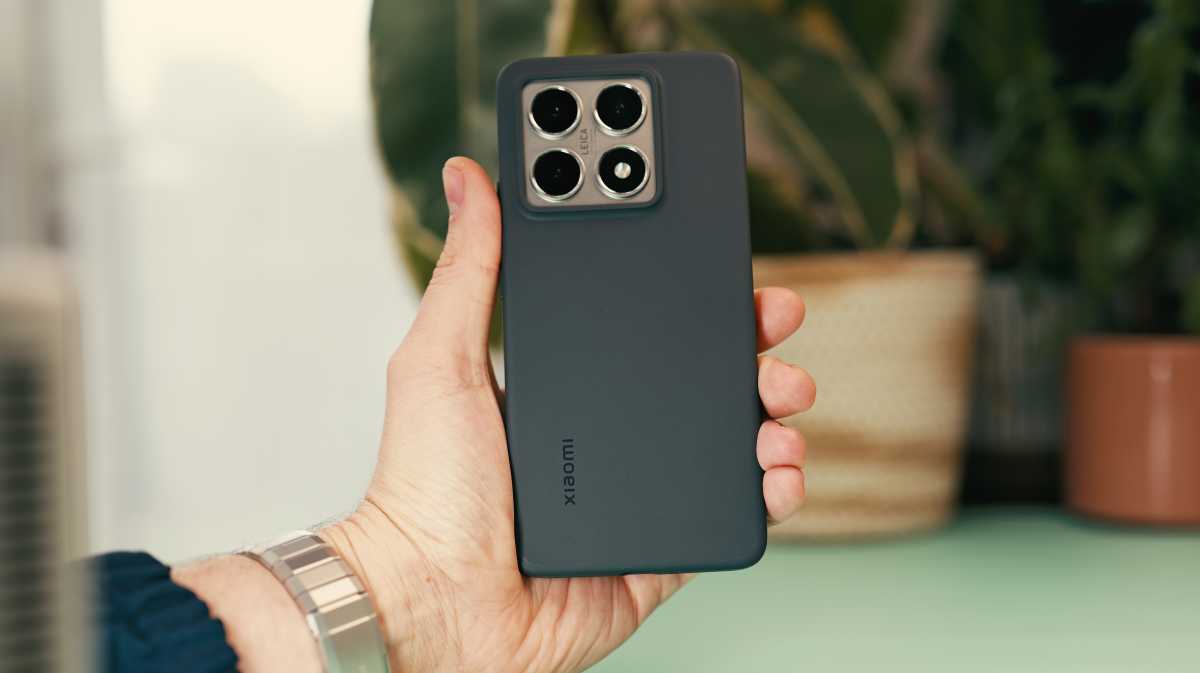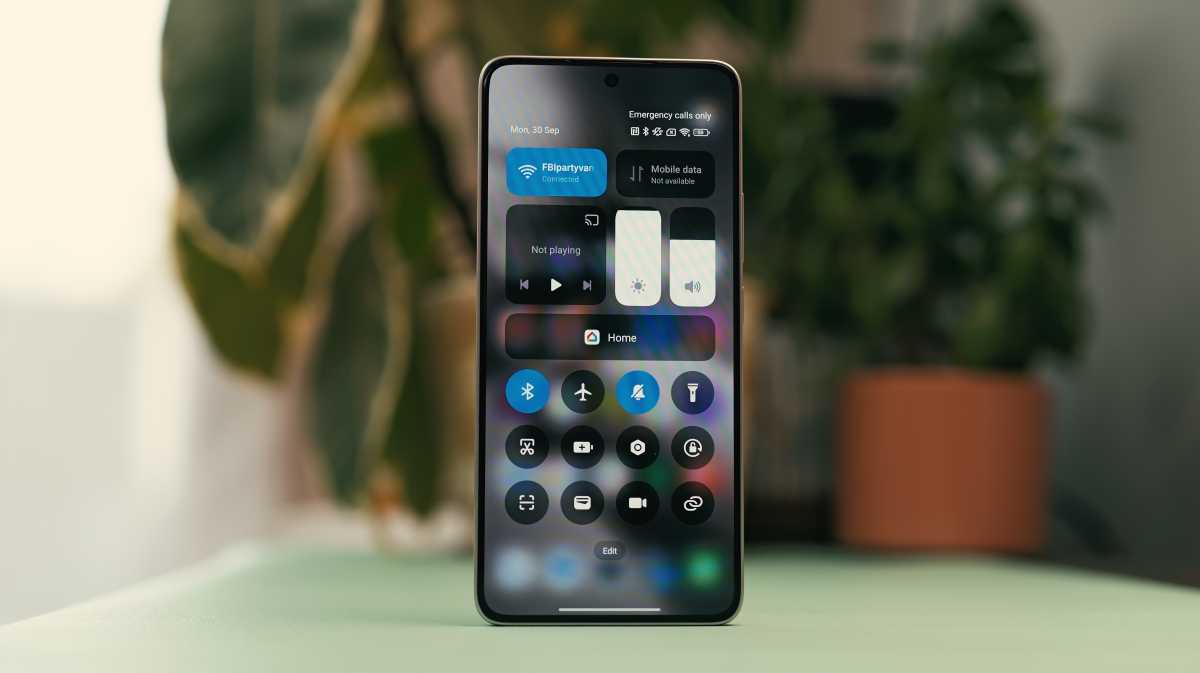Expert’s Rating
Pros
- Slick design
- Brilliant cameras
- Circle to Search and Gemini support
- Solid performance
- Speedy charging
Cons
- No charger included
- No wireless charging
- Plastic frame
- Own-brand AI is a mixed bag
Our Verdict
The Xiaomi 14T is an affordable handset that could easily be mistaken for a flagship device. It performs well, takes great photos, has a stunning display and charges quickly. The Pro model may have a more well-rounded spec sheet, but if you opt for the cheapest model, you get a similar experience at a very attractive price.
Price When Reviewed
This value will show the geolocated pricing text for product undefined
Best Pricing Today
Price When Reviewed
Unavailable in the US
Xiaomi’s latest ‘flagship killers’ have landed. The 14T series aims to bridge the gap between the upper mid-range and fully-fledged flagship devices. They deliver impressive specs, a Leica-branded camera partnership, and some very desirable features at a more approachable price point.
However, while the Xiaomi 14T Pro has captured most of the limelight, its cheaper sibling, the 14T, deserves your attention, too. This model has a lower-tier processor at its core, but it offers a very similar design, similarly impressive snappers and many of the same features – all for just £549.
At face value, it seems like one of the best mid-range deals on the market today, but what’s it like to live with?
I stuffed the Xiaomi 14T in my pocket and used it as my main handset for the past week. I’ve used it for everything, from photography and video to productivity and gaming and here’s how I got on.
Design & Build
- 7.8mm, 195g
- Glass back, aluminium-effect plastic frame
- IP68 rated
The Xiaomi 14T is almost identical to the Xiaomi 14T Pro, with the only major difference being that the Pro has some added curvature on its rear panel. The regular 14T has a completely flat front and rear, and in some ways, I prefer it.
the combination of this colourway and the boxy shape gives the device some retro charm

Luke Baker
Just like its pricier sibling, it’s available with a metallic-looking finish, and I think that the combination of this colourway and the boxy shape gives the device some retro charm. It reminds me of a Walkman from the 70s, or to use a more contemporary example, Teenage Engineering’s TP-7.
Despite outward appearances, though, there’s basically no metal to be found here. The rear is a frosted matt-effect glass panel and the frame is plastic with an aluminium-effect paintjob. This is the single biggest design difference between the two 14T variants, as the Pro comes with a frame that’s actually made from metal.
I was pleased to find that the silvery finish doesn’t pick up fingerprints too easily, and it’s not overly slippy in the hand either. However, that’s not something that matters too much, as there’s a decent matte-black TPU case included in the box.
If you don’t like the Titan Gray model on show here, there are also Titan Black, Titan Blue and Lemon Green options.

Luke Baker
It’s a fairly large phone, with dimensions that are just shy of the iPhone 16 Pro Max. However, it’s a bit slimmer and noticeably lighter than Apple’s biggest handset at 195g. The camera bump is very minimal, and the lenses only protrude from the rear by a few millimetres. This means there’s very little rocking when you place it screen-up on your desk.
The phone has an IP68 rating, so you can take it to the beach without worry – or more likely at this time of year, use it in a serious rain storm. It has Gorilla Glass 5 covering the screen, and while Xiaomi hasn’t boasted about its durability, plastic-framed phones often fare well in the event of an accidental drop.
The haptic feedback is surprisingly good for this class of phone, it’s often an area where brands like to cut corners, as it’s not always immediately noticeable. But, the Xiaomi 14T haptics feels just as good as the flagship Xiaomi 14. The vibrations are precise and powerful, it’s very helpful when typing at speed.
Screen & Speakers
- 6.67-inch 144Hz AMOLED display
- 2712×1220 pixels, 4000 nits
- Stereo speakers
The Xiaomi 14T has identical screen specifications to the Xiaomi 14T Pro, and the Xiaomi 13T Pro, for that matter.
That’s a good thing, it’s speedy, bright and highly responsive.

Luke Baker
A refresh rate of 144Hz is still a rarity, outside of specialist gaming phones, so it’s nice to see here. However, I wouldn’t expect it to make a noticeable difference compared to 120Hz rivals. Most games don’t support such high refresh rates, and you’d be hard-pressed to tell the difference when swiping around the OS. The important thing is that it feels super smooth and snappy.
The display can peak at 4000 nits brightness under certain conditions, which is very bright indeed. It had no trouble competing with direct sunlight and colours remained vibrant and accurate in all conditions. HDR content looks superb on this display, too.
HDR content looks superb on this display
It’s a fully flat display, which means there are no odd reflections like you might see on a curvy display, and rarely any accidental touches, either. The bezel is symmetrical all the way around, and relatively slim, too. It makes the phone look a touch more premium than its mid-range rivals.

Luke Baker
There’s a fingerprint reader under the display, and it’s your run-of-the-mill optical unit. It works reliably enough, but it might take a couple of tries in wet conditions or when your hands are especially cold. The phone also supports face unlock, so you can avoid the reader most of the time, if you prefer.
Thankfully, this model houses the same stereo speakers as its pricier sibling, and they do a great job. There’s plenty of detail and clarity, although they do lack the bass response that you’ll find on more expensive flagship devices.
Still, they’re miles better than the mono speaker setups that are surprisingly common in this price bracket.
Specs & Performance
- MediaTek Dimensity 8300 Ultra
- 12GB RAM
- 256GB / 512GB storage
The Xiaomi 14T is powered by the MediaTek Dimensity 8300 Ultra, the same chip inside the Poco X6 Pro (also a Xiaomi brand).
In this case, it’s paired with 12GB of RAM and either 256- or 512GB of storage. As usual, there’s no microSD card support on this model so choose wisely.
In either case, it’s a generous sum. You’ll have no issues with heavy multitasking and you can load up the phone with a vast library of photos, videos, games and apps.

Luke Baker
The Dimensity 8300 Ultra is a sub-flagship chip, but it’s still quite the performer. It impressed us when we reviewed the Poco X6 Pro, and that’s very much the case here, too.
Don’t expect it to trade blows with the mighty Snapdragon 8 Gen 3, but it bests the Tensor G4 from the Pixel 9 phones in some graphically intensive tasks.
I found it could comfortably run Genshin Impact on the highest graphical preset at 30fps, and if you don’t mind a few frame drops, 60fps remains playable, too.
Outside of some very specific workloads, it’s hard to tell the difference between this and a proper flagship chipset
The Pro version of the 14T might be more powerful, but even if you like a bit of gaming, you’re not likely to be disappointed. Outside of some very specific workloads, it’s hard to tell the difference between this and a proper flagship chipset.
The only real downside is that it gets pretty toasty while gaming, you’ll want to keep the included TPU case on to keep that heat away from your fingertips. Surprisingly, though, there wasn’t much noticeable throttling when playing for an extended period.
Xiaomi 14T benchmarks
Cameras
- 50Mp main camera
- 12Mp ultrawide
- 50Mp 2x periscope telephoto
- 32Mp selfie camera
The Xiaomi 14T has a triple camera setup on the rear comprised of a 50Mp f/1.7 1/1.56-inch main sensor, a 50Mp f/1.9 2x telephoto and a 12Mp f/2.2 ultrawide.
Compared to the 14T Pro, you get a slightly smaller sensor on the main lens, less reach on the telephoto and the same ultrawide camera. Around the front, you get the same 32Mp punch-hole selfie camera.
shots from the main lens often looked more impressive than photos from my iPhone 16 Pro

Luke Baker
It’s a step down in hardware specifications compared to the Pro model, but looking at the results, you might have difficulty telling. Straight out of the camera, shots from the main lens often looked more impressive than photos from my iPhone 16 Pro. It’s an amazing feat for a phone that costs around half the price.
Just like the Xiaomi 14 Ultra, and the 14T Pro, this phone benefits from Xiaomi’s partnership with Leica. This means you get the excellent Leica Authentic and Leica Vibrant colour profiles, as well as numerous Leica-approved filters to give your photos a more unique look.
Photos look sharp, detailed and lifelike with excellent dynamic range. I really like how the Leica Authentic profile adds a touch of contrast to clouds for a more dramatic overall image, too.
The main camera is the most impressive, and that’s especially true in dimmer conditions, but the telephoto is a decent performer in the daylight. The ultrawide is less impressive, lacking some definition and sharpness compared to the other lenses. There’s also no autofocus on the ultrawide, so you can’t use it for close-ups, and I find that quite limiting.
The selfie camera is decent, but it’s a little prone to motion blur in low-light conditions. There’s no autofocus, so you’ll need to stand in the sweet spot to get the best result, but on occasion, it’ll deliver some impressive snaps.
Xiaomi’s portrait mode effects are really nice, and there are plenty of different bokeh styles to choose from, all with their own unique characteristics. The only downside is that the cut-outs are quite sharp and angular compared to the competition. It detects the edges well, but the sharp cut-off doesn’t always look the most natural.
What really surprised me with this phone is the wealth of professional video features that are supported.
You get full manual control over the camera, if you want it, as well as the ability to shoot in LOG. You can even import your own LUTs and use them for monitoring and recording. It puts many top-tier flagships to shame – although it’s worth noting only the main lens supports LOG shooting.
Battery Life & Charging
- 5000mAh battery
- 67W charging
- No charger in the box
The Xiaomi 14T has the same 5000mAh battery capacity as the Pro but it’s paired with a lower-end processor, which gave me high hopes for battery life.
In use, it’s good, but not as impressive as I had hoped. Still, the phone will see you through a day of relatively heavy use with ease, which is all you really need.
I usually went to bed with around 20% remaining, so realistically, you can expect to charge it every day.

Luke Baker
The Xiaomi 14T supports 67W wired charging. It’s pretty speedy, and can take you from flat to full in under 45 minutes. Meanwhile, a 15-minute charge should get you above 50%. Unfortunately, there’s no charger supplied in the box, so you might need to factor in the cost of a speedy charger to take full advantage of these speeds.
There’s no wireless charging on this model, but it’s still fairly rare in this price bracket, so that can be forgiven. You can always step up to the Pro if you need wireless charging, as that model can charge at a whopping 50W without needing to plug in, far quicker than the likes of Samsung, Google and Apple.
Software & Apps
- HyperOS, based on Android 14
- Circle to Search and Gemini
- AI features
The 14T runs HyperOS, Xiaomi’s custom flavor of Android 14. If you’ve used a recent Xiaomi or Poco phone, then you’re in for a very familiar experience.
It might have a new name, but HyperOS functions almost identically to MIUI, just the aesthetics have a little more polish to them.

Luke Baker
This means it takes some getting used to if you’re switching from another Android brand. The notifications shade and quick settings are split, like they are in iOS, and there’s no app drawer activated by default.
HyperOS has a pretty stylised look, too, but it’s highly customisable if it’s not to your tastes. It’s not my favourite Android skin, but with some tweaking, you can get it to behave a little more typically.
There’s quite a lot of bloatware pre-installed, as well as folders full of suggested apps. It’s not ideal, but I do appreciate that there doesn’t seem to be an upper limit on the amount of apps you can select in bulk. It means you can just nuke everything in one go and start fresh with a blank home screen.
What’s new this time around is a deeper integration with Google’s services.

Luke Baker
What’s new this time around is a deeper integration with Google’s services. This will be one of the first phones other than Samsung or Pixel to get Circle to Search functionality. It hasn’t arrived yet, but it will sometime in October.
I’m really happy to see this, Circle to Seach is one of those features that becomes second nature very quickly. I have my fingers crossed that it rolls out to other Android devices in the future, too.
It doesn’t stop there, either. On this phone, you’ll find Google Gemini as the default voice assistant like the Pixel 9 series, and Gemini also popped up asking if I wanted writing assistance in my messages. There seems to be a lot more synergy between Google and Xiaomi than we’ve seen in previous generations.
Xiaomi has promised plenty of its own AI features, too, but most of them aren’t available yet. There’s an AI Subtitle generating function, but it’s not very intuitive and you need to sign up as a beta tester in its current state. Most of the other AI features are promised in future updates, like the AI Interpreter, AI Notes and more.
Interestingly, there are some pretty advanced AI image editing tools available, but you have to add a plug-in to the gallery app to unlock them.
Once you do, you’ll be able to use a more advanced version of the AI eraser and expand the FOV of an image, while generative AI fills in the gaps. The results aren’t perfect, but they definitely rival Samsung’s Galaxy AI options.
Price & Availability
The Xiaomi 14T starts at £549/€649 with 12GB of RAM and 256GB of storage, it’s also available with 512GB of storage for £599/€699. As usual for Xiaomi devices, it’s not officially sold in the US.
You can buy the phone directly from Xiaomi or via a third-party retailer like Amazon. We haven’t found any contract deals for the Xiaomi 14T just yet, so if you pick one up, be sure to check out our guide to the best SIM only deals.
The price means it undercuts many true flagships but you could also consider phones like the Google Pixel 8a, OnePlus Nord 4 and Nothing Phone (2a) Plus if you want something cheaper.
Check out our chart of the best mid-range phones to see what the Xiaomi 14T is up against.
Should you buy the Xiaomi 14T?
The Xiaomi 14T offers great value for money, and you don’t lose out on too much by opting for this model over the more expensive Pro variant. You get a striking design, a lovely display, great cameras, solid performance and all the same software features. On a daily basis, chances are that you’ll barely notice the difference.
That said, the Pro model has some very distinct advantages, and for a lot of people, it’ll be worth the extra outlay. It has a metal frame, more impressive gaming performance, better main and telephoto sensors and wireless charging. Personally, I’d happily pay an extra £100/€150 for those features, but it’s nice to have this option for those who don’t value them as much.
There’s lots of competition at this price point, but the Xiaomi 14T stands out as one of the most compelling options. I think you’d be hard-pressed to find a phone with better photographic chops at this price, although the Honor 200 Pro can often be found discounted for a similar sum, and that’s certainly a strong contender.
If the styling and features appeal, the Xiaomi 14T won’t disappoint, it has been a pleasure to live with. It’s an almost-flagship experience at half the price.
Specs
- Android 14
- 6.67-inch, 1220 x 2712, OLED, 144Hz
- Under-display fingerprint sensor
- MediaTek Dimensity 8300 Ultra
- 12GB RAM
- 256GB / 512GB storage
- Cameras:
- 50Mp main camera
- 12Mp ultrawide
- 50Mp 2x telephoto
- 32Mp selfie camera
- Up to 4K @ 60fps rear video
- Stereo speakers
- Dual-SIM + eSIM
- Wi-Fi 802.11 a/b/g/n/ac/ax/be
- Bluetooth 5.4
- 5000mAh battery
- 67W charging
- 160.5 x 75.1 x 7.8 mm
- IP68 certified
- 195g
- Colours: Lemon Green, Titan Black, Titan Gray, Titan Blue
Read the full article here












